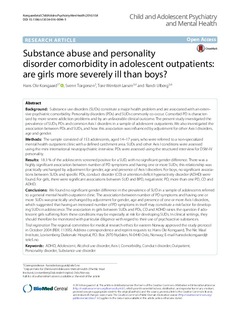| dc.description.abstract | Background Substance use disorders (SUDs) constitute a major health problem and are associated with an extensive psychiatric comorbidity. Personality disorders (PDs) and SUDs commonly co-occur. Comorbid PD is characterized by more severe addiction problems and by an unfavorable clinical outcome. The present study investigated the prevalence of SUDs, PDs and common Axis I disorders in a sample of adolescent outpatients. We also investigated the association between PDs and SUDs, and how this association was influenced by adjustment for other Axis I disorders, age and gender. Methods The sample consisted of 153 adolescents, aged 14–17 years, who were referred to a non-specialized mental health outpatient clinic with a defined catchment area. SUDs and other Axis I conditions were assessed using the mini international neuropsychiatric interview. PDs were assessed using the structured interview for DSM-IV personality. Results 18.3 % of the adolescents screened positive for a SUD, with no significant gender difference. There was a highly significant association between number of PD symptoms and having one or more SUDs; this relationship was practically unchanged by adjustment for gender, age and presence of Axis I disorders. For boys, no significant associations between SUDs and specific PDs, conduct disorder (CD) or attention deficit hyperactivity disorder (ADHD) were found. For girls, there were significant associations between SUD and BPD, negativistic PD, more than one PD, CD and ADHD. Conclusions We found no significant gender difference in the prevalence of SUD in a sample of adolescents referred to a general mental health outpatient clinic. The association between number of PD symptoms and having one or more SUDs was practically unchanged by adjustment for gender, age and presence of one or more Axis I disorders, which suggested that having an increased number of PD symptoms in itself may constitute a risk factor for developing SUDs in adolescence. The association in girls between SUDs and PDs, CD and ADHD raises the question if adolescent girls suffering from these conditions may be especially at risk for developing SUDs. In clinical settings, they should therefore be monitored with particular diligence with regard to their use of psychoactive substances. | |
